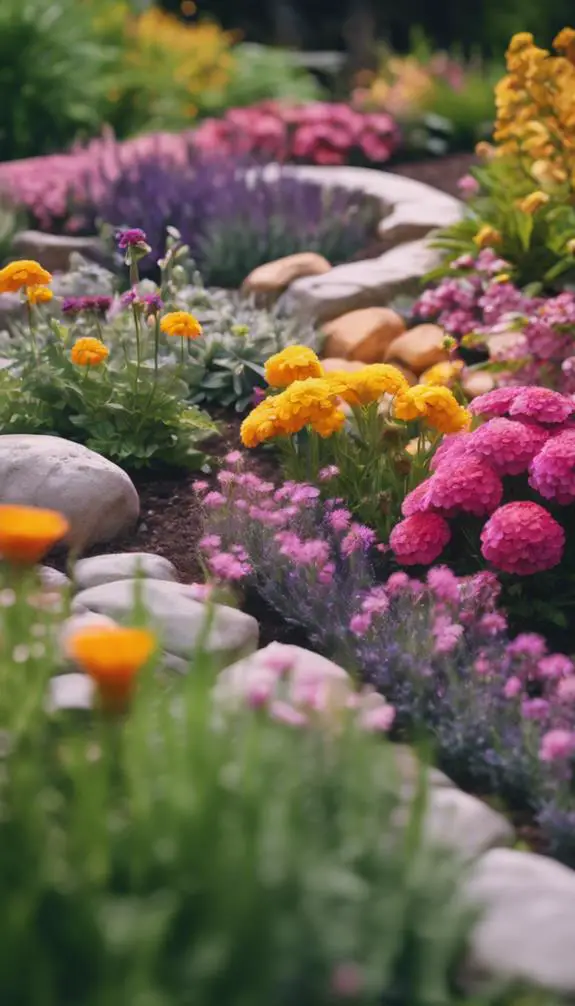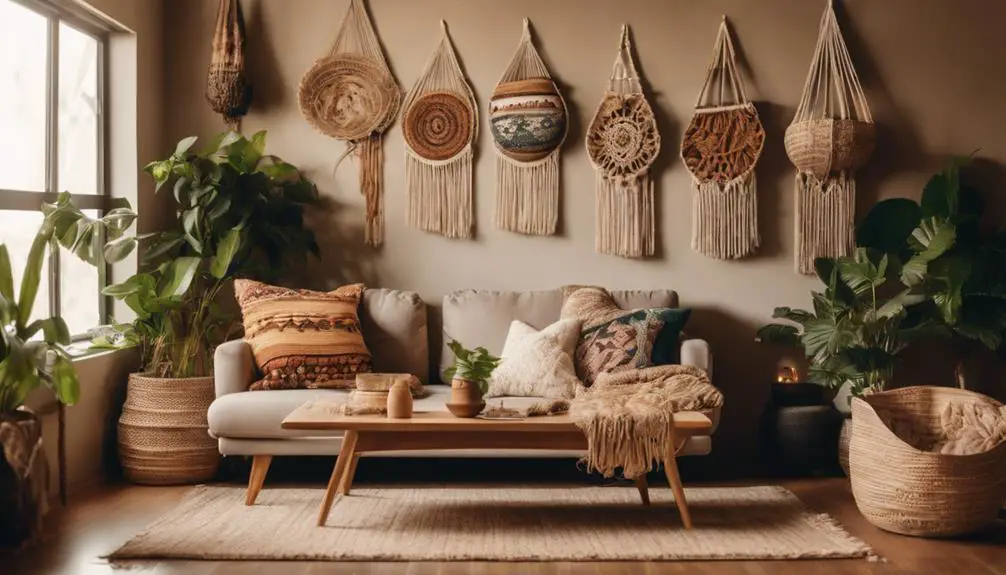As you consider creating a rock garden, you're likely wondering what style will best suit your outdoor space. Do you envision a modern, sleek design or a more rustic, natural look? Perhaps you're drawn to unique themed gardens or water feature rock gardens that incorporate the soothing sounds of water. Whatever your vision, the key to creating a stunning rock garden lies in carefully selecting the right elements. In the following sections, you'll discover inspiration and practical tips to help you bring your rock garden to life, from choosing the perfect rocks to pairing them with complementary plants.
Modern Rock Garden Designs

Incorporating sleek lines, geometric shapes, and carefully selected plant species, modern rock garden designs transform outdoor spaces into sophisticated, low-maintenance oases that showcase nature's beauty.
As you envision your modern rock garden, consider the role of modern textures in creating visual interest. Combining smooth stones with rough-hewn boulders or incorporating metallic accents can add depth and dimension to your design.
Urban accents, such as corten steel planters or reclaimed wood benches, can bring a touch of industrial chic to your outdoor space.
To elevate your design, choose plants with architectural forms, like succulents or ornamental grasses, and arrange them in a way that creates movement and flow.
Consider incorporating a small water feature, like a bubbler or rill, to add the soothing sound of water to your oasis.
Rustic and Natural-Looking Creations
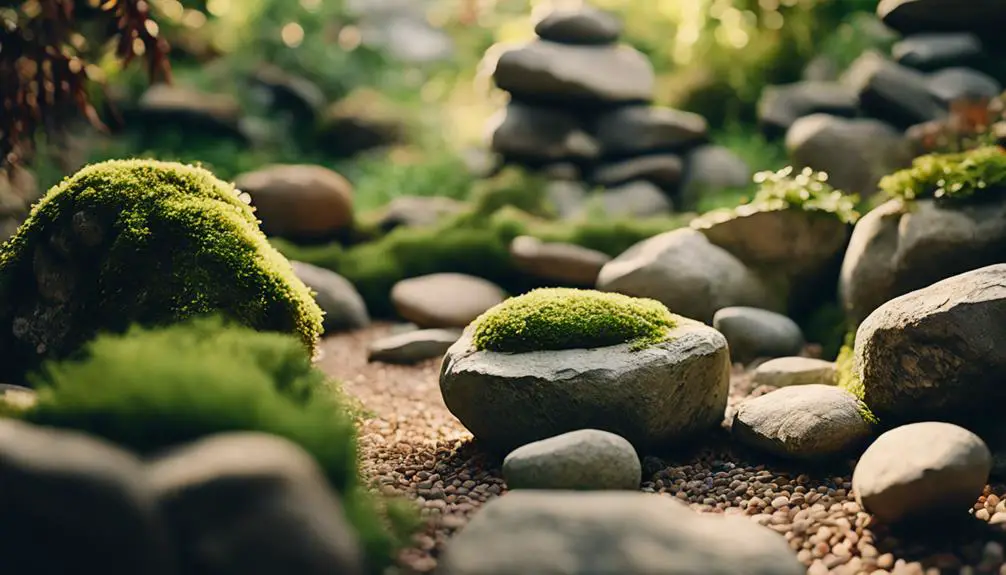
As you design your rustic rock garden, you'll want to ponder the harmony of earthy elements.
You can create visually striking arrangements by combining rough-hewn stones of varying textures and sizes, and then softening the landscape with lush moss or ferns.
Earthy Stone Arrangements
You can create earthy stone arrangements by layering weathered rocks, pebbles, and boulders in a harmonious manner, allowing their natural textures and colors to shine.
To achieve a visually appealing composition, experiment with different stone patterns, such as alternating large and small rocks or creating a radial pattern with smaller stones surrounding a central boulder.
Earthy accents like moss, lichen, or ferns can be incorporated to add a touch of greenery and soften the overall look.
Consider the natural colors and textures of the stones when selecting them.
For example, weathered rocks with a warm, golden hue can evoke a sense of rustic charm, while smoother, grey pebbles can create a more modern, sleek look.
Play with the arrangement's height and depth by combining flat stones with taller, more vertical elements.
You can also incorporate natural elements like driftwood or branches to add interest and create a sense of movement.
Mossy Hillside Scenes
By incorporating moss into your rock garden design, you can evoke the serene ambiance of a mossy hillside, where lush greenery clings to weathered stones and creates a sense of ageless tranquility.
To achieve this look, start by selecting a mix of moss species that thrive in shade and partial sunlight. Plant them in crevices and cracks between rocks, allowing them to spill over the edges and create a soft, velvety texture. As the moss grows, it will begin to cascade down the rocky slopes, creating a mossy hillside effect.
To enhance the natural beauty of your mossy slopes, incorporate hillside retreats into your design. Create seating areas amidst the rocks, using weathered stone benches or natural outcroppings as seating. Add a meandering path that winds its way up the hillside, inviting visitors to explore the tranquil atmosphere.
As you walk along the path, the mossy slopes will envelop you, creating a sense of seclusion and serenity. With careful planning and attention to detail, you can create a mossy hillside scene that transports you to a secluded, natural oasis.
Weathered Wooden Accents
Weathered wooden accents, such as driftwood benches or reclaimed wood planters, inject a sense of rustic charm into your rock garden design, complementing the natural beauty of the mossy hillside scenes.
You can incorporate faded benches, adorned with moss and lichen, to create a sense of aged elegance. Alternatively, use driftwood decor to add a touch of coastal charm to your garden.
Consider incorporating reclaimed wood planters, filled with lush greenery, to bring warmth and texture to your design.
When selecting weathered wooden accents, look for pieces with unique character, such as gnarled branches or distressed finishes. These imperfections will add depth and visual interest to your garden.
You can also repurpose old wooden pallets or crates to create one-of-a-kind planters or benches.
Small Space Rock Garden Ideas

In compact urban spaces, creative rock garden designs can thrive in areas as small as a few square feet, where every stone, plant, and decorative element is deliberately chosen to maximize visual impact.
You can create tiny oases in even the smallest of spaces, such as a balcony or patio, by using compact layouts that make the most of every inch.
Consider a vertical rock garden, where stones and plants are stacked in a decorative manner, adding depth and texture to the space.
Alternatively, use a small, shallow container to create a miniature rock garden, complete with small rocks, succulents, and mosses.
To add visual interest, incorporate small decorative elements, such as seashells, pebbles, or small sculptures, that complement the colors and textures of the rocks and plants.
Large Area Rock Landscaping

As you begin designing your large area rock landscaping, you'll want to ponder the overall aesthetic you're aiming for, and that starts with deciding on a rock formation design that complements your outdoor space.
You'll need to strategically place natural stones to create visual interest and balance, taking into account the scale and proportions of your area.
Rock Formation Designs
How will you arrange massive boulders, rocks, and stones to create a visually striking rock formation that dominates your large outdoor space?
To achieve a dramatic effect, ponder creating rock patterns that lead the viewer's eye through the landscape. You can create a sense of movement by arranging rocks in a serpentine pattern or a more static, grid-like design. Boulder clusters can add visual interest by creating a focal point in your rock formation. Group boulders of varying sizes and textures to create a sense of depth and dimensionality.
When selecting rocks, weigh their color, texture, and shape. Contrasting colors and textures can create a visually appealing contrast, while similar rocks can create a sense of cohesion.
Think about the scale of your rock formation, too. Larger rocks can make a bigger impact, but smaller rocks can be used to create a more intricate design.
Don't forget to ponder the surrounding landscape when designing your rock formation. You can incorporate plants, water features, or other design elements to create a cohesive and visually stunning outdoor space.
Natural Stone Placement
You'll need to strategically place natural stones across your large outdoor space to create a harmonious and balanced landscape that complements your rock formation design.
To achieve this, ponder creating stone patterns that guide the viewer's eye through the space. For instance, you can place smaller stones in a meandering pattern, leading visitors through the garden. Alternatively, use larger stones to create a sense of rhythm, placing them in a repetitive pattern to create visual interest.
Boulder clusters can add depth and texture to your landscape.
Group three to five large stones together, varying their sizes and shapes to create visual harmony. Ponder placing them in a triangular formation, with the largest stone at the base and smaller stones radiating outward. This will create a sense of balance and stability.
When placing natural stones, remember to weigh their color, texture, and shape. Contrasting stones can add visual interest, while similar stones can create a sense of cohesion.
Landscaping Focal Points
Large area rock landscaping often benefits from incorporating landscaping focal points, which draw the viewer's attention to a specific area of the garden and create visual anchors that guide the eye through the space.
By strategically placing statement pieces, such as large boulders, sculptures, or water features, you can create a sense of balance and harmony in your rock garden.
These visual anchors not only add visual interest but also help to break up the space, creating separate areas within the larger landscape.
When selecting focal points, consider the overall aesthetic you want to achieve.
Do you want to create a dramatic, eye-catching feature or a more subtle, naturalistic look?
Choose statement pieces that complement the surrounding rocks and plants, and don't be afraid to experiment with different textures, colors, and shapes.
Water Feature Rock Gardens

Creating a serene ambiance, a water feature rock garden harmoniously blends the soothing sounds of trickling water with the natural beauty of rocks and plants.
As you design your water feature rock garden, consider incorporating a small water fall or fountain to create a visually appealing display.
The gentle flow of water will create a calming atmosphere, perfect for relaxation.
To enhance the visual appeal, strategically place rocks and plants around the water feature to create a natural, organic look.
You can use large rocks or boulders to create a natural-looking waterfall or fountain, while smaller rocks and pebbles can be used to line the water's edge.
The sound of running water will create a sense of tranquility, making your water feature rock garden a perfect oasis in your backyard.
Succulent and Rock Combinations

As you design your succulent and rock combination, you'll want to ponder the overall aesthetic you're aiming for, whether it's a desert landscape-inspired arrangement or a harmonious blend of rocks and plants.
Think about how the colors and textures of your succulents will interact with the rocks you've chosen, and experiment with different combinations to find the perfect balance.
Desert Landscape Inspiration
By incorporating succulents with varying textures and shapes among strategically placed rocks, you can craft a desert landscape that's both visually striking and low-maintenance.
To create a stunning desert landscape, start by selecting succulents with unique shapes and sizes, such as aloe, echeveria, and crassula. Combine these with rocks of different textures, like smooth river rocks and rough boulders, to add depth and visual interest.
As you design your desert landscape, consider incorporating desert blooms like ocotillo or Texas sage to add a pop of color and soften the ruggedness of the rocks.
To enhance the arid textures, use a mix of gravel, decomposed granite, or sand as the base material. This will also help with drainage and prevent waterlogged soil.
When placing your succulents and rocks, think about creating a visually appealing pattern. You can create a focal point with a large boulder or succulent, and then balance it with smaller elements around it.
Don't be afraid to experiment and move things around until you achieve a look that's uniquely yours. With a little creativity, you can create a desert landscape that's both beautiful and low-maintenance.
Rock and Plant Harmony
You'll elevate your desert landscape design by pairing succulents with complementary rocks that enhance their unique shapes, textures, and colors.
This harmonious union is all about creating a visually stunning contrast between the smooth, rounded forms of rocks and the architectural shapes of succulents.
To achieve rock and plant harmony, consider the rock aesthetics: choose rocks with varying sizes, textures, and hues to add depth and dimension to your design.
For instance, pair soft, pastel-hued succulents with rough, weathered rocks or bold, geometric succulents with sleek, black rocks.
This synergy between plant and rock will create an arresting visual dialogue.
When selecting succulents, look for species with striking foliage, such as aloe, echeveria, or crassula, and place them among rocks that mirror their shape or color.
Succulent Color Schemes
When crafting succulent color schemes, pair bold, brightly hued succulents like echeveria or crassula with rocks that echo their vibrant tones, creating a visual fireworks display that electrifies your desert landscape.
This harmonious union of succulent and rock creates a Succulent Harmony that's both striking and serene.
For a Color Burst effect, combine succulents with complementary rock hues. For instance, pair blue-gray echeveria with warm, rust-colored rocks or vibrant orange crassula with cool, gray-blue stones.
This deliberate color pairing amplifies the visual impact of your rock garden, drawing the eye to specific areas and creating a sense of movement.
To take it up a notch, experiment with contrasting textures – smooth, rounded rocks alongside spiky, architectural succulents or rough, granite-like stones paired with delicate, trailing varieties.
Colorful Rock Garden Designs
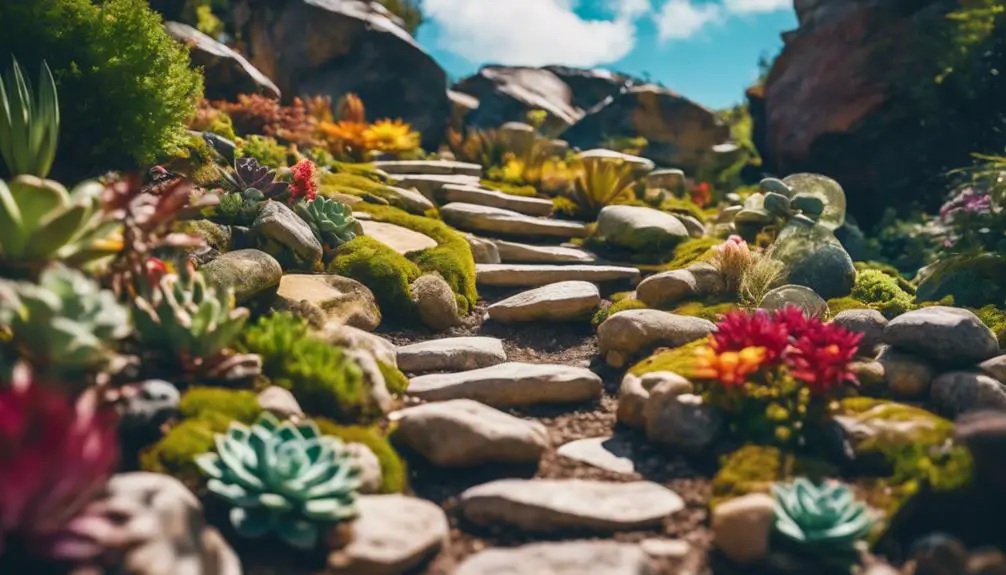
Incorporating vibrant flowers, succulents, and decorative stones, your colorful rock garden design can burst with personality and visual appeal.
To create a show-stopping display, start by selecting Vibrant Blooms that complement your garden's color scheme. Consider pairing bold, bright flowers like petunias or marigolds with more subtle, pastel-hued succulents. This contrast will add depth and visual interest to your design.
Next, add Whimsical Accents to give your garden a playful, eclectic feel. Use decorative stones in unique shapes or colors to create a mosaic pattern or add a touch of glamour with metallic accents like copper or bronze.
You can also incorporate small ornaments, like tiny sculptures or wind chimes, to add an element of surprise. When combining these elements, remember to balance bold statements with more subdued features to avoid visual overload.
Rock and Mulch Combinations
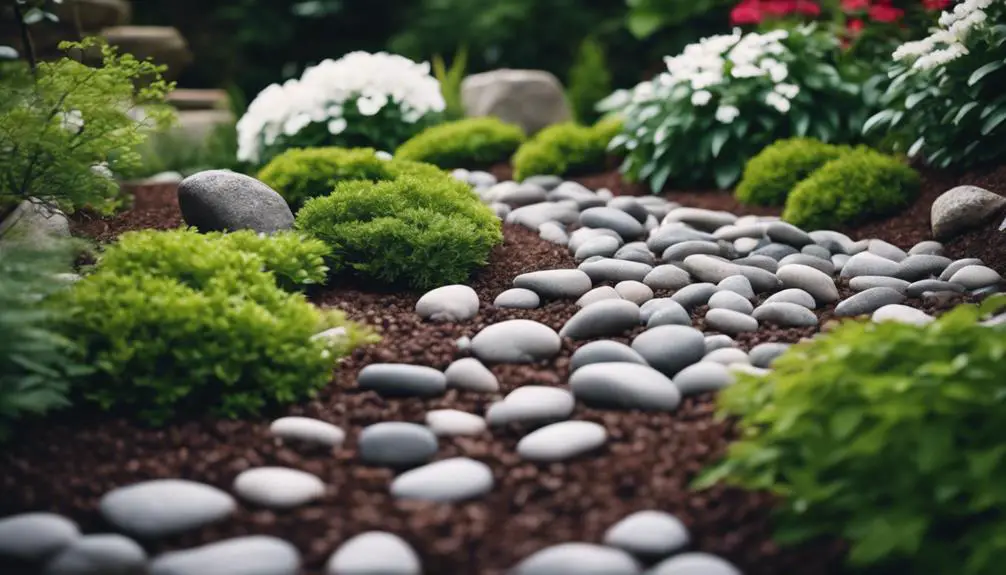
By combining rocks of varying sizes and textures with different types of mulch, you can create a visually appealing contrast that adds depth and dimension to your rock garden.
To achieve this, consider pairing rocks with distinct textures, such as smooth river rocks, rough granite boulders, or weathered lava rocks, with a variety of mulch types.
Organic mulch options like wood chips, bark, or pine straw can add a natural, earthy tone to your garden, while inorganic mulch like gravel or decomposed granite can provide a more modern, sleek look.
When selecting mulch varieties, think about the color and texture you want to introduce to your garden.
For example, a dark-colored mulch like cocoa hulls can create a striking contrast with light-colored rocks, while a light-colored mulch like straw can help to highlight the natural tones of the rocks.
DIY Rock Garden Projects
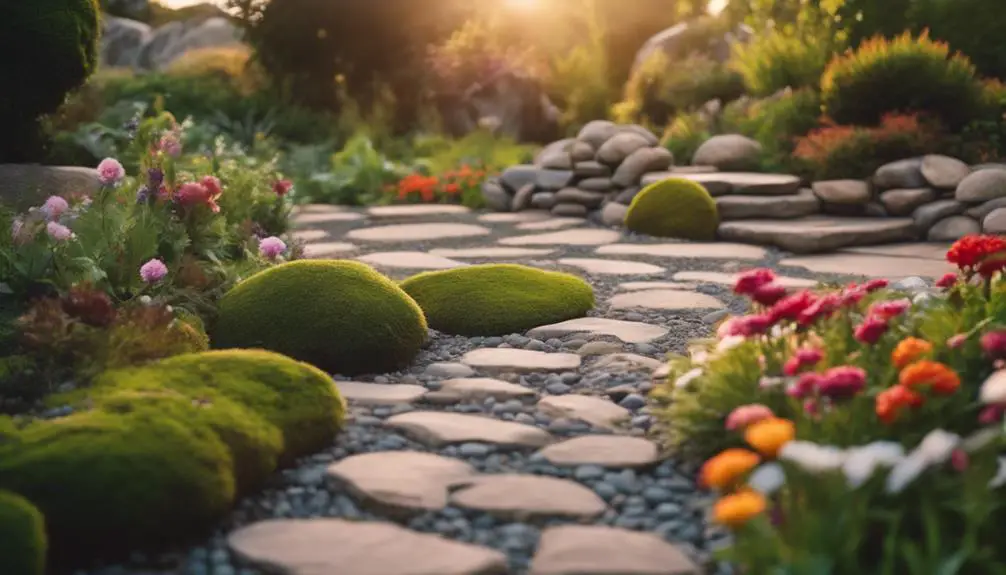
Your creativity can shine through in a DIY rock garden project, where you can thoughtfully arrange rocks, plants, and decorative elements to craft a unique, miniature landscape that reflects your personal style.
Start by selecting rocks that complement each other with regard to shape, size, and color. Consider the overall aesthetic you want to achieve and choose rocks that fit within those creative boundaries. You can use large rocks as statement pieces, accompanied by smaller rocks and gravel to create a visually appealing contrast.
Next, think about the plants you want to incorporate into your design. Succulents and alpine plants work well in rock gardens, as they thrive in well-draining soil and can tolerate dry conditions. Consider the mature size of the plants and leave enough space for them to grow.
Rock Garden Edging Ideas
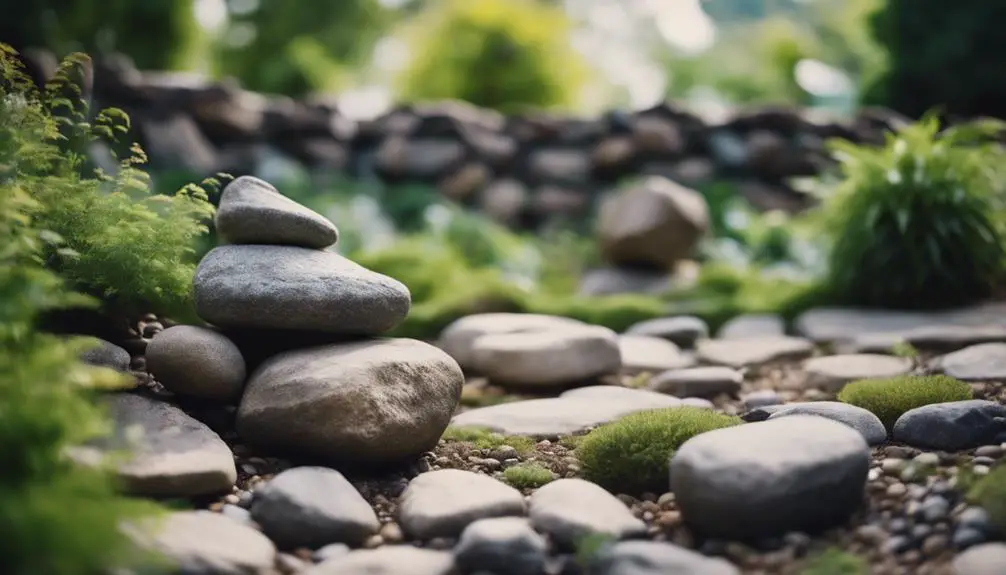
As you define the boundaries of your DIY rock garden, carefully selecting an edging material that complements the colors and textures of your rocks and plants becomes key to creating a cohesive look.
You'll want to choose an edging material that not only defines the space but also enhances the overall aesthetic. Rock borders or stone boundaries can add a sense of sophistication and elegance to your garden.
Consider using natural stone edging, such as bluestone or fieldstone, which will blend seamlessly with your rock garden. Alternatively, metal or plastic edging can provide a clean, modern look.
Make sure to choose an edging material that can withstand the elements and won't damage your plants. Consider the style and theme of your garden when selecting an edging material, and don't be afraid to get creative.
For example, you could use a combination of rock and metal edging to create a unique, industrial-chic look. Whatever you choose, make sure it complements your rock garden and adds to its visual appeal.
Incorporating Statues and Ornaments

Positioning statues and ornaments thoughtfully throughout your rock garden creates visual interest and adds personality to the space.
You can choose statues that reflect your personal style, from modern and sleek to whimsical and playful.
Consider incorporating Mythic Figures, such as mythical creatures or ancient gods, to add a touch of fantasy to your garden. These statues can be placed among the rocks, creating a sense of discovery and surprise as visitors explore the garden.
Whimsical Accents, like fairy doors or miniature furniture, can also add a playful touch to your rock garden.
These ornaments can be tucked among the rocks or nestled in crevices, creating a sense of wonder and enchantment.
When selecting statues and ornaments, consider the scale and material to guarantee they blend seamlessly with the rocks and plants.
You can also group statues and ornaments together to create a focal point or vignette, drawing the eye to a particular area of the garden.
Rock and Plant Pairing Tips

Six key factors influence the harmony of rock and plant pairings in your garden: texture, color, scale, form, growth habit, and light requirements.
As you select rocks and plants, consider how these elements will interact. For instance, pair rough-textured rocks with smooth-leaved plants or delicate flowers with chunky rocks.
Balance warm-colored rocks with cool-toned plants, and guarantee the scale of your rocks and plants is proportionate. Form-wise, combine upright plants with horizontal rocks or vice versa.
Consider the growth habit of your plants, too – will they spill over the rocks or grow upright through them? Finally, make sure your rock and plant pairings share similar light requirements.
When preparing your soil, keep in mind the specific needs of your plants. Some plants thrive in well-draining soil, while others prefer moisture-rich environments.
Your rock selection should also inform your soil preparation. For example, if you've chosen dense, porous rocks, you may need to adjust your soil composition to guarantee adequate drainage.
Unique Rock Garden Themes
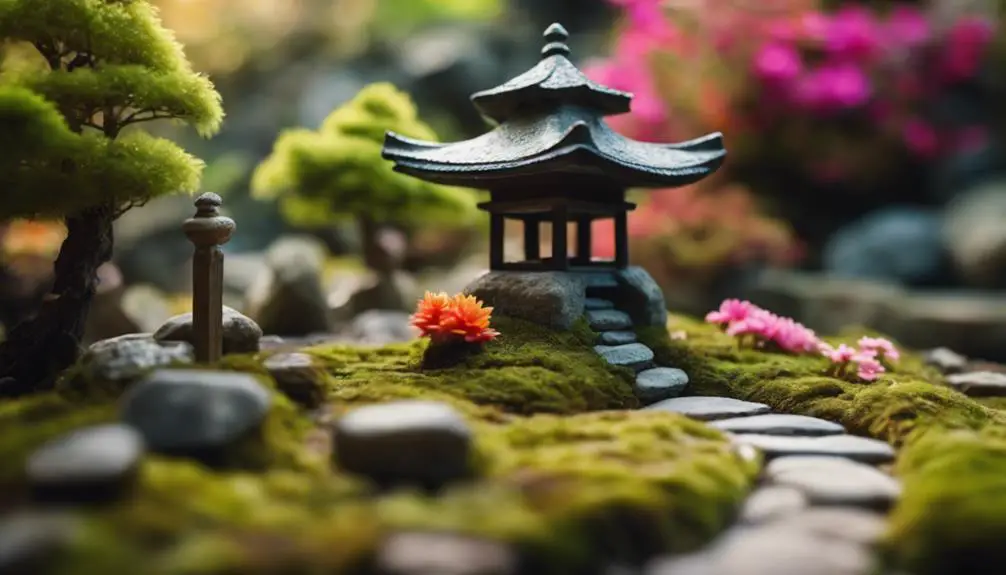
You can create a one-of-a-kind rock garden by exploring unique themes that reflect your personality, such as a Zen-inspired oasis, a whimsical fairy garden, or a rugged alpine landscape.
These rock fantasies can be brought to life by incorporating specific elements, textures, and colors that evoke a particular mood or atmosphere. For instance, a Zen-inspired oasis might feature smooth, weathered rocks, moss, and carefully pruned shrubs, while a whimsical fairy garden might incorporate miniature furniture, twinkling lights, and vibrant flowers.
When designing your rock garden, think about the narrative you want to tell. What story do you want your garden to convey? Do you want to evoke a sense of serenity, adventure, or wonder?
Your garden narrative should guide your choices of rocks, plants, and decorative elements. Consider the scale, texture, and color of each element to guarantee they work harmoniously together.
Frequently Asked Questions
Can I Use Rocks From My Own Backyard in My Rock Garden?
You can definitely source rocks from your own backyard, adding a personal touch to your design. Just guarantee they're suitable for outdoor use, clean them thoroughly, and consider their color, texture, and size to create a visually appealing arrangement.
How Do I Stop Weeds From Growing in My Rock Garden?
To prevent weeds from taking over, you'll want to implement a weed barrier, like landscape fabric or plastic sheeting, then add a thick mulch layer, ensuring a 2-3 inch gap between rocks to prevent weed seeds from germinating.
Are Rock Gardens High Maintenance or Low Maintenance?
You'll find that a well-designed space, with meticulous rock placement and thorough soil preparation, can be low maintenance, but it requires an initial investment of time and effort to achieve a visually stunning, weed-free haven.
Can I Create a Rock Garden on a Slope or Hill?
When tackling a slope or hill, you'll need to prioritize slope stabilization and hillside landscaping strategies to prevent erosion, ensuring a solid foundation for your design, then carefully select plants and materials that thrive in these conditions.
How Deep Should the Rocks Be in My Rock Garden Design?
When designing your slope or hill garden, you'll want to achieve a balanced rock coverage of 2-4 inches deep, with a visually appealing rock distribution that allows for 30-50% soil exposure, creating a harmonious blend of texture and growth.
Conclusion
As you finalize your rock garden design, remember to balance texture, color, and form to create visual harmony.
Consider the surrounding landscape and architecture to guarantee a cohesive look.
Don't be afraid to experiment with unique pairings of rocks, plants, and ornaments to reflect your personal style.
With these rock garden ideas, you'll be well on your way to crafting a serene outdoor oasis that's both beautiful and functional.


